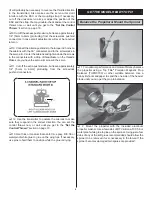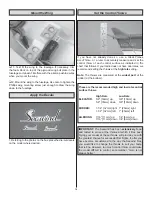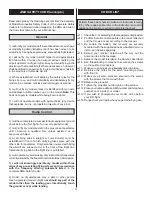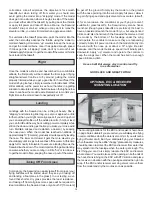
13
AMA SAFETY CODE (excerpts)
Read and abide by the following excerpts from the Academy
of Model Aeronautics Safety Code. For the complete Safety
Code refer to Model Aviation magazine, the AMA web site or
the Code that came with your AMA license.
General
1) I will not fl y my model aircraft in sanctioned events, air shows,
or model fl ying demonstrations until it has been proven to be
airworthy by having been previously, successfully fl ight tested.
2) I will not fl y my model aircraft higher than approximately
400 feet within 3 miles of an airport without notifying the
airport operator. I will give right-of-way and avoid fl ying in the
proximity of full-scale aircraft. Where necessary, an observer
shall be utilized to supervise fl ying to avoid having models fl y
in the proximity of full-scale aircraft.
3) Where established, I will abide by the safety rules for the
fl ying site I use, and I will not willfully and deliberately fl y my
models in a careless, reckless and/or dangerous manner.
5) I will not fl y my model unless it is identifi ed with my name
and address or AMA number, on or in the model. Note: This
does not apply to models while being fl own indoors.
7) I will not operate models with pyrotechnics (any device
that explodes, burns, or propels a projectile of any kind).
Radio Control
1) I will have completed a successful radio equipment ground
check before the fi rst fl ight of a new or repaired model.
2) I will not fl y my model aircraft in the presence of spectators
until I become a qualifi ed fl ier, unless assisted by an
experienced helper.
3) At all fl ying sites a straight or curved line(s) must be
established in front of which all fl ying takes place with the
other side for spectators. Only personnel involved with fl ying
the aircraft are allowed at or in the front of the fl ight line.
Intentional fl ying behind the fl ight line is prohibited.
4) I will operate my model using only radio control frequencies
currently allowed by the Federal Communications Commission.
5) I will not knowingly operate my model within three
miles of any pre-existing fl ying site except in accordance
with the frequency sharing agreement listed (in the
complete AMA Safety Code).
9) Under no circumstances may a pilot or other person
touch a powered model in fl ight; nor should any part of the
model other than the landing gear, intentionally touch
the ground, except while landing.
CHECK LIST
Perform these basic checks to make sure the model is ready
to fl y. Where appropriate, refer to the instruction manual for
additional information required to complete the check.
❏
1. Check the C.G. according to the measurements provided.
❏
2.
Confi rm that all controls operate in the correct direction
and the throws are set according to the manual.
❏
3.
Be certain the battery and receiver are securely
mounted with the supplied adhesive-backed Velcro or
Velcro purchased separately.
❏
4.
Extend your receiver antenna all the way out the
antenna tube in the fuselage.
❏
5. Balance the model laterally in the water as described.
❏
6.
Use threadlocking compound to secure all the screws
on the pushrod connectors.
❏
7. Make sure all hinges are securely glued in place.
❏
8.
Reinforce the holes for the servo mounting screws
with thin CA.
❏
9.
Make sure all servo arms are secured to the servos
with the screws that came with them.
❏
10. Balance the propeller.
❏
11. Tighten the propeller nut and glue on the spinner.
❏
12. Place your name, address, AMA number and telephone
number on or inside your model.
❏
13. If you wish to photograph your model, do so before
your fi rst fl ight.
❏
14. Range check your radio when you get to the fl ying site.


































